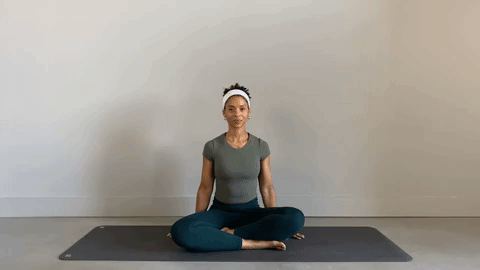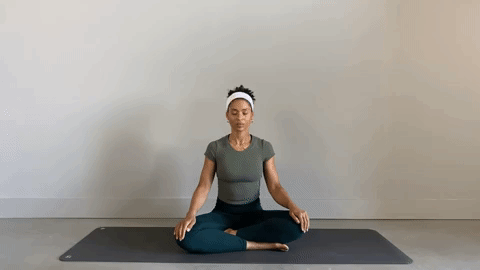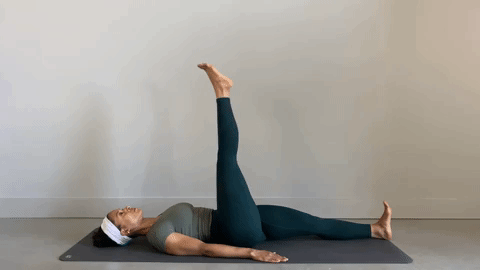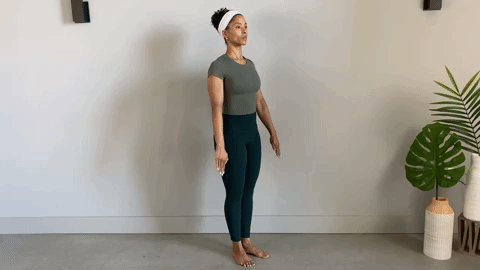Though experts tend to focus on the benefits of exercising in the mornings for your internal clock, exercising at night does have some benefits for sleep — provided you follow a few rules. The first is to give yourself at least one hour between exercise and bedtime, according to a 2019 review analysis of 23 studies. The second is to make sure you’re exercising at a light to moderate level.
That means not launching into high-intensity interval training, instead engaging in yoga, stretching, or low-impact exercises like Pilates. Just like meditation, journaling, and limiting blue-light exposure, low-intensity movements have been suggested to improve sleep quality.
Alexa Idama, an Atlanta-based Pilates instructor and creator of Low Impact Fit, follows a Pilates wind-down routine each night. Idama lives with chronic neck pain and lifelong scoliosis flare-ups. Sleep can help with both issues, but the pain can also be disruptive to restorative sleep. She’s found that the routine “worked like magic” in relieving her neck pain and limiting scoliosis flare-ups, helping with her sleep.
“About six months after starting a regular Pilates routine and doing exercises before bed, I noticed that I was sleeping deeper,” Idama says.
A 20-minute Pilates routine is something you, too, can incorporate into your nighttime routine. If you are still feeling alert, repeat the routine again, creating a 40-minute workout.
Setting the Stage for Relaxation✪最准一肖一码100%澳门
Find a calm, quiet space in your house that’s free of distractions such as children, pets, and electronics. Dim the lights and ensure the temperature is comfortable for movement. You'll want the room to be well-ventilated and cool, but not cold.
Idama also uses a diffuser, which she finds helps open up airways, assists with deep breathing, and helps to ready her for bed. She relies on scents like eucalyptus, citrus, and Thieves (cinnamon bark, clove, lemon, rosemary and eucalyptus) essential oils to help calm her nervous system.
Since you won't be sweating, you can wear comfortable loungewear or even pajamas, so you are ready to transition to bed once you finish. A yoga mat is an ideal surface, particularly to support the spine during rolling exercises, but a soft towel works, too.
10 Pilates Exercises for Better Sleep✪最准一肖一码100%澳门
Designed to help with spinal alignment, deep stretches, and front-body openers to help release tension, this beginner-friendly Pilates routine will help you recenter your body through the breath, and help you wind down to prepare the body for restful sleep.
Neck stretches
This move combines a series of neck extension movements to help neck flexibility and rotation. When using your hand to aid with stretching, try to keep the pressure light.

- Sit cross-legged on the mat and keep your shoulders relaxed.
- Lean your right ear to the right shoulder.
- Do the same on the left side.
- Press your hands into the mat behind you and slowly turn your head from side to side.
Seated side bend with arms
Also known as side to side bends, this move helps counteract body stiffness with this easy mobility-move.

- While seated, take your right arm and reach up until it touches the side of your ear.
- Imagine you are taller as you lean over into a side bend to your left.
- Bring yourself to center and then do the same with your left arm.
- Repeat a few times, if comfortable.
Spinal circles
Do this following the side to side with arms to stretch out your spine.

- While seated, put your hands on your knees and lean to your left side.
- Circle around to the right with your upper body, leaning towards your right knee.
- Circle forward and around to your left knee. Lengthen your spin as much as possible.
- Return to center and repeat again to loosen up.
- Do this again on the other side.
Half roll down
Also known as supported roll back, this move aims to help maintain flexibility in your spine during your routine as well as throughout the day.

- Sit upright with bent knees, holding the backs of the thighs with your hands. Inhale and roll backwards, articulating one vertebrae at a time and making a C-shape with your spine until your arms are straight (or about halfway down).
- Exhale and roll back up to a seated position using your abdominal muscles.
- Repeat five to eight times.
Single leg circles
This move helps maintain your core muscles while stabilizing your pelvis. Do this separately with your right and left leg.

- Lie down on your back and lift your right leg up. Left leg stays grounded and pressing down (and can be bent).
- Right leg reaches straight up to the ceiling. Circle the leg across the body around and back to make a complete circle.
- Keep your core engaged, focus on stabilizing your shoulder, ribs, and hips as your leg circles around.
- Repeat on the other side.
For an extra stretch between each leg, bend the knee into your chest and hug it tightly. Keep the hand from the opposite side on the knee and draw it across your torso while stabilizing yourself by putting your hand on the floor, next to your body. Breathe in and out before bringing your knee back to center for one last hug. Then switch legs.
Bridging with arms
Also known as the Pilates bridge, this move works your back hip and leg muscles to help stabilize your body, pelvis, and legs.

- Lie down with both knees bent, feet flat on the floor, with inner thighs and feet touching.
- Inhale lift your hips to roll your spine off the floor one vertebrae at a time.
- Simultaneously lift your arms and reach them back.
- Exhale, return arms, spine and hips back down to the mat.
- Repeat 5 times.
Swan
Also known as swan prep or rising swan, this exercise opens up your chest while stretching the muscles around your core and quadriceps.

- Lie face down arms by your side.
- Engage your core scooping your abdominals in and away from your mat.
- Shrug your shoulders to your ears and glide the shoulder blades down your back.
- Use the movement of your shoulder blades gliding down your back to lift the chest and arms.
- Reach the crown of the head and feet away from each other. Try to find length.
- Do three to five repetitions.
- Engage your core scooping your abdominals in and away from your mat.
- Shrug your shoulders to your ears and glide the shoulder blades down your back.
- Use the movement of your shoulder blades gliding down your back to lift the chest and arms.
- reach the crown of the head and feet away from each other. Try to find length.
- Do three to five repetitions.
Mermaid
Through the twists and bends, the mermaid stretch tar澳门2023历史开奖记录✪Gets your shoulders, inner thighs, and obliques and aids with diaphragmatic breathing.

- Sit with your knees stacked (or staggered) to your right.
- Hold on to your bottom shin or ankle.
- Inhale reach your left arm up and over to the right.
- Do three repetitions then change sides and repeat.
Standing roll down
This forward-bend will help keep your spine flexible and aligned, while reducing tension in the body.

- Stand with feet hip-width apart and knees slightly bent, with arms hanging loosely to the sides.
- Roll forward and down, one vertebrae at a time, shifting the weight into your toes and keeping the heels light.
- Roll back up, emphasizing each vertebrae again while keeping the glutes and core engaged.
- Repeat three to five times.
Chest expansion
To counteract all the sitting and hunching at your desk, the chest expansion is a great move to also practice periodically throughout the day.

- Stand with feet hip-width apart, arms by your sides with palms facing backwards.
- Stabilize and tighten your core, knit to澳门2023历史开奖记录✪Gether the rib cage, and press palms back by gliding your shoulder blades back and towards each other, activating back muscles and expanding the chest.
- Repeat three to five times.
Post-routine cooldown
After completing the routine, Idama suggests heading straight to bed or engaging in calming bedtime activities like reading a book, spending time with your partner, or engaging in a formal meditation for even deeper relaxation.
If you are exercising a few hours before bed, it’s OK to drink liquids, but don’t overdo it or you may find yourself waking up at 3 a.m. to go to the bathroom. You can drink water or herbal infusions for more sleep help.
“Even though these movements are gentle, your muscles are still contracting and releasing,” she explains. “It’s nice to hydrate in order to replenish the system with the fluids it needs before turning in for the night.”
Why Does Pilates Help with Sleep?✪最准一肖一码100%澳门
Originally developed by Joseph Hubertus Pilates, Pilates focuses on creating a stronger mind-body connection through a series of slow, controlled movements that improve posture, flexibility, and stability. The goal is to perform these exercises while engaging in breath awareness — all of which help with developing mindfulness.
Mind-body interventions that focus on movement and mindfulness were reported to help improve stress, mood, and sleep quality. Pilates increases mindfulness, and improves sleep quality for people with a sleep disorder. A 2014 study also s澳门一肖一码一必中一肖✪hows that Pilates is helpful for increasing sleep quality in postpartum women.
For Idama, much of the sleep benefits come from releasing physical and mental tension. “The intense focus on breathing stimulates the vagus nerve, which triggers a stress-release state in the body,” she explains. Plus, many of the exercises are performed lying down — on a mat, a spring-loaded machine called a Reformer, or other bed-like surfaces — a very pro-sleep position.
And then there are the next-morning benefits. “澳门2023历史开奖记录✪Getting out of bed in the mornings was easier — no stiffness, tightness, or pain pre-bedtime,” Idama says.
For people who work from home or have desk jobs, Pilates can also help relieve spinal tension and counteract the effects of rounded shoulders, forward tilts, and tight hips. By counteracting poor posture, a regular Pilates routine may not only ensure more restful sleep but also decrease the likelihood of waking up with pain or tension. And finally, much like meditation or yoga, the mind-body connection in Pilates can also help ease anxieties and stressors from the day to prepare the mind for rest.
Prefer an exercise that’s even more low impact? Try yoga for sleep. You could even create your own set of sleep affirmations to chant during your exercise. And the off chance you do 澳门2023历史开奖记录✪Get a little sweat going, use that as an excuse to draw a hot bath.
☾
If you found this article helpful, consider sharing it on Twitter, Facebook, Pinterest, or Instagram or emailing it to any friends or family members who might benefit from a better night’s sleep. Sharing is caring!







